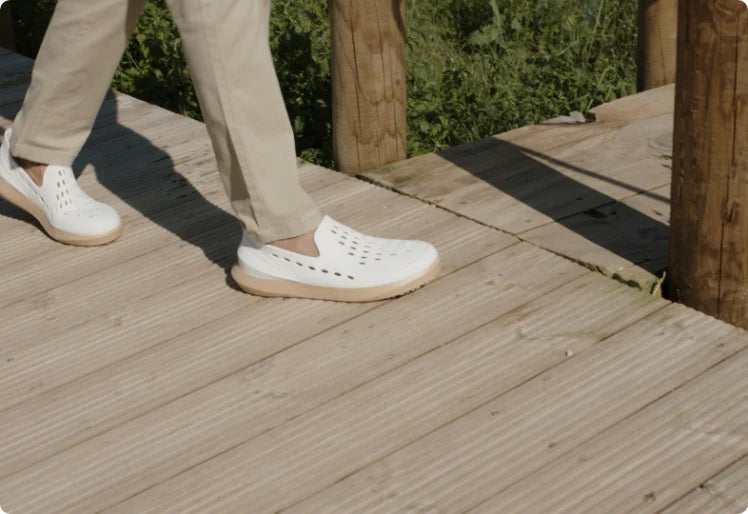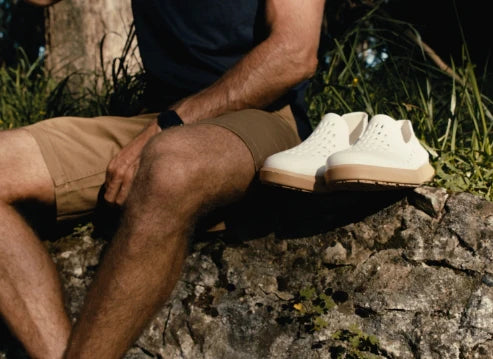Non-slip shoes are extremely important. They are specially designed to provide better traction on slippery surfaces, such as wet or oily floors, which helps to significantly reduce the chances of accidents like slips, trips, and falls. This is especially crucial in various work environments where such accidents are common.
If you're looking for high-quality non-slip shoes, you can explore the best-selling collection from Strato Footwear. Their shoes are designed with superior grip and durability to ensure your safety in various environments.
Understanding Non-Slip Shoes
Non-slip shoes are specifically designed footwear that provides superior grip and stability on slippery surfaces. They feature synthetic rubber soles which enhance traction, preventing slips and falls on wet or oily surfaces. These shoes are essential for ensuring safety in various environments, from commercial kitchens to construction sites.
Features and Benefits of Wearing Non-Slip Shoes
Wearing non-slip shoes offers numerous benefits:
- Better Grip: The synthetic rubber soles of non-slip shoes provide a firm grip, reducing the risk of slipping on smooth, wet, or oily floors.
- Durable Outsoles: These shoes often have sturdy EVA rubber outsoles that not only offer durability but also prevent water from getting trapped underneath, enhancing slip resistance.
- Patterned Tread: The tread patterns, particularly those with small-scale hexagons, are designed to maximize traction. This design helps disperse liquids and prevent slippage effectively.
- Comfort and Safety: Non-slip shoes are constructed with additional features like padded collars and cushioned midsoles for comfort during extended wear. This makes them ideal for professionals who spend long hours on their feet.
- Versatility: Many non-slip shoe designs cater to different industries and environments. This versatility ensures that workers in various sectors can find suitable footwear that meets their specific safety needs.
For a variety of stylish and functional non-slip shoes, you might want to explore the offerings by Strato Footwear. Their wide range of options ensures that professionals in different sectors can find suitable footwear that meets their specific safety needs.
Non-slip shoes play a crucial role in accident prevention by providing necessary traction and support in high-risk areas. Their unique features make them indispensable for maintaining workplace safety.
How to Determine If Shoes Are Non-Slip
One of the easiest ways to tell if a pair of shoes is non-slip is by examining the product descriptions and labels. Manufacturers often highlight slip-resistant features in their marketing materials to attract safety-conscious consumers. Here’s what you should look for:
Inspecting Outsoles for Slip-Resistance Features
If you're shopping in-store or have already purchased a pair, a visual inspection of the outsoles can reveal much about their slip-resistance capabilities.
- Material: Non-slip shoes commonly have outsoles made from synthetic rubber or EVA (Ethylene Vinyl Acetate). These materials offer excellent grip on wet or oily surfaces.
- Tread Patterns: The tread pattern is another critical aspect. Shoes with hexagonal tread patterns are particularly effective at providing slip resistance. Small-scale hexagons create multiple points of contact with the ground, enhancing grip.
- Flexibility: A flexible outsole can adapt better to uneven surfaces, improving traction. Bend the shoe slightly to see how flexible it is.
- Depth and Width of Grooves: Deeper and wider grooves enhance water dispersion, preventing liquid from being trapped underfoot. This feature is especially beneficial when walking on wet surfaces.
Practical Tips for Spotting Slip-Resistant Outsoles
- Visual Inspection: Look closely at the outsole design. Complex patterns with multiple angles usually offer better traction than plain, flat surfaces.
- Feel Test: Run your fingers along the sole; a tacky or sticky feel often indicates good slip resistance.
- Quick Checkpoints
- Material: Synthetic rubber or EVA
- Tread Pattern: Hexagonal designs
- Flexibility: Bend test
- Groove Depth: Deep and wide
By combining both methods—checking product descriptions and inspecting outsoles—you can confidently determine if a pair of shoes meets your slip-resistant needs.
This comprehensive approach ensures that you are well-equipped to make an informed choice, minimizing risks related to slips and falls in various environments.

Key Features to Look for in Ideal Non-Slip Work Shoes
Choosing the right type of non-slip footwear is crucial, especially for work environments where safety is paramount. Here are some key features to consider:
Lightweight and Durable Construction with Soft Outsoles
- Lightweight Materials: Non-slip work shoes should be made from lightweight materials to reduce fatigue during long hours of wear.
- Durable Anti-Skid Soles: The outsoles should be constructed from durable, anti-skid materials like synthetic rubber, which provide better grip on wet or oily surfaces.
- Soft Outsoles: Soft outsoles help in maintaining a secure grip by adapting to the surface texture, enhancing slip-resistance. EVA rubber is often used for its softness and durability.
Slip-Resistant Tread Patterns: Exploring Hexagonal Designs
- Patterned Tread: Look for shoes with patterned tread designs. These patterns are essential for channeling liquids away from the shoe surface, preventing slips.
- Hexagonal Designs: Shoes with hexagonal tread patterns offer superior slip resistance. The small-scale hexagons create multiple points of contact with the ground, improving traction and stability.
Comfort and Support Features for Extended Wear
Comfort and support are vital for those who spend long hours on their feet. Consider the following features:
- Padded Collars: Padded collars provide additional comfort around the ankle area, reducing friction and preventing blisters.
- Water/Stain Resistance: Uppers made from water- and stain-resistant materials help keep the shoes looking new while protecting your feet from moisture.
- Orthotic Footbeds with Arch Support: Orthotic footbeds offer customized support, reducing foot fatigue and improving overall comfort.
- Cushioned Midsoles: Cushioned midsoles absorb shock and provide extra comfort during prolonged wear.
- Adequate Toe Boxes: A spacious toe box ensures that your toes have enough room to move freely, preventing discomfort and potential injuries.
By focusing on these key features—lightweight construction, durable anti-skid soles, effective tread patterns, and enhanced comfort—you can ensure that you choose the ideal non-slip work shoes for any environment.
Ensuring Safety with Versatile Non-Slip Shoe Designs
The Need for Versatility in Non-Slip Footwear
Non-slip shoes must cater to a variety of work environments, which means versatility is crucial. Different industries have unique demands, so a one-size-fits-all approach doesn't work.
- Adaptability: Shoes should handle various surfaces, from wet kitchen floors to oily garages.
- Durability: High-quality materials ensure longevity, even with heavy use.
- Comfort: Since workers often spend long hours on their feet, comfort cannot be compromised.
Examples of Industries That Require Non-Slip Shoes
Several industries rely heavily on non-slip footwear to ensure worker safety. These include:
Healthcare:
- Hospitals and clinics often have slick floors due to spills and frequent cleaning.
- Staff need shoes that provide excellent grip and comfort for long shifts.
Restaurants:
- Kitchens are prone to wet and greasy surfaces.
- Chefs, servers, and other staff require slip-resistant shoes to avoid accidents.
Construction:
- Sites can be unpredictable with uneven terrain and various hazards.
- Durable, non-slip footwear is necessary to prevent slips and injuries.
Manufacturing:
- Factories often have oil or chemical spills.
- Workers need shoes that offer both slip-resistance and protection from harmful substances.
Retail:
- Stores may have polished floors that become slippery when wet.
- Staff benefit from non-slip shoes for better stability during their shifts.
Warehouse and Logistics:
- Warehouses often have slick concrete floors.
- Employees require sturdy, non-slip shoes to navigate safely around the facility.

Conclusion
Non-slip shoes are essential for preventing slips, trips, and falls and reducing the risk of injuries in various settings. Whether you work in a busy kitchen, on a construction site, or in a warehouse, wearing the right footwear is crucial for workplace safety.
Key Points to Remember:
- Preventing accidents and injuries: Non-slip shoes are designed to provide better grip on wet or oily surfaces, which helps in avoiding potential mishaps.
- Identifying non-slip footwear:Check product descriptions and labels: Look for terms like "slip-resistant" or "non-slip."
- Inspect outsoles: Patterns like small-scale hexagons often indicate superior slip resistance.
Investing in non-slip footwear is not just about compliance with safety regulations; it's about ensuring your personal well-being and that of those around you. By understanding what features to look for and how to identify them, you can make informed decisions that contribute to a safer work environment.




